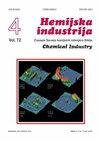新型孔板的计算流体力学分析
IF 0.8
4区 工程技术
Q4 ENGINEERING, CHEMICAL
引用次数: 0
摘要
在许多技术中,例如过程工业或供水,都需要测量流体流量。孔板具有许多优点,是测量管道流体流量最常用的仪器。另一方面,它们的使用增加了工厂和管道的运营成本。在这项工作中,设计和测试了三种新的孔板形式。这些新的表格和一个标准,作为参考,设计使用SolidWorks软件包。新设计的目的是节约能源,从而降低运营成本。通过这样的设计可以实现节能,减少了管道元件孔板的阻力。这是通过增加孔板的开放部分来实现的,允许流体流动。将孔板的CAD模型转换为STL文件,进一步用于CFD模拟和实验复制品的3D打印。根据所提出的算法,在COMSOL Multiphysics软件包中使用有限差分法对新设计进行了CFD模拟测试。所使用的方程是基于Reynolds形式的Navier-Stokes方程(RANS, Reynolds-average Navier-Stokes)和不可压缩流体的连续性方程。接下来,正如我们在开发新孔板设计的算法中所提出的那样,利用3D打印技术和FDM(熔融沉积建模)工艺制作实验孔板,并在实验室条件下进行测试。将室内试验结果与CFD模拟结果进行了比较。与参考(V0)相比,三种新孔板形式(V1)中的第一种已经实现了相当多的节能。对于其他两种提议的形式,节能效果要低得多。通过CFD模拟,可以获得数据,根据这些数据可以决定是否需要对测量装置的新形状进行修正或是否适合进一步的实验室测试。结果表明,本文提出的测试算法可用于设计新型孔板。本文章由计算机程序翻译,如有差异,请以英文原文为准。
Analysis of new forms of orifice plates using computational fluid dynamics
In many technologies, such as process industry or water supply, there is a need to measure fluid flowrates. Orifice plates are the most common instruments for measuring the fluid flowrate through pipelines due to their many advantages. On the other side, their use increases operating costs of industrial plants and pipelines. In this work, three new forms of orifice plates were designed and tested. These new forms and one standard, which served as a reference, were designed by using the SolidWorks software package. The aim of the new designs was energy savings, and consequently reduction of operating costs. Energy savings can be achieved by such a design, which decreases the orifice plate resistance an element of the pipeline. This was achieved by increasing the open part of the orifice plate permitting the fluid flow. CAD models of orifice plates were transferred to STL files that were further used for CFD simulation as well as 3D printing of experimental replicas. According to the proposed algorithm, the new designs were tested by CFD simulation performed in the COMSOL Multiphysics software package, by using a finite-difference method. Equations used were based on the Reynolds form of Navier-Stokes equations (RANS, Reynolds-averaged Navier-Stokes), and the continuity equation for incompressible fluids. Next, as we have proposed in our algorithm of development of new orifice plate designs, experimental orifice plates were made by using 3D printing technology and FDM (Fused Deposition Modeling) procedure and tested at laboratory conditions. The results of laboratory tests were compared with the results of CFD simulation. A considerable amount of energy saving was indicated, which was achieved already by the first of the three new orifice plate forms (V1) as compared to the reference (V0). For the other two proposed forms, the effect of energy savings was considerably lower. By using CFD simulation, data can be obtained based on which a decision can be made whether the new shape of the measuring device should be corrected or is appropriate for further laboratory tests. Based on the presented results it can be concluded that the proposed testing algorithm proved useful in designing new forms of orifice plates.
求助全文
通过发布文献求助,成功后即可免费获取论文全文。
去求助
来源期刊

Hemijska Industrija
工程技术-工程:化工
CiteScore
1.60
自引率
11.10%
发文量
12
审稿时长
6-12 weeks
期刊介绍:
The Journal Hemijska industrija (abbreviation Hem. Ind.) is publishing papers in the field of Chemical Engineering (Transport phenomena; Process Modeling, Simulation and Optimization; Thermodynamics; Separation Processes; Reactor Engineering; Electrochemical Engineering; Petrochemical Engineering), Biochemical Engineering (Bioreactors; Protein Engineering; Kinetics of Bioprocesses), Engineering of Materials (Polymers; Metal materials; Non-metal materials; Biomaterials), Environmental Engineeringand Applied Chemistry. The journal is published bimonthly by the Association of Chemical Engineers of Serbia (a member of EFCE - European Federation of Chemical Engineering). In addition to professional articles of importance to industry, scientific research papers are published, not only from our country but from all over the world. It also contains topics such as business news, science and technology news, information on new apparatus and equipment, and articles on environmental protection.
 求助内容:
求助内容: 应助结果提醒方式:
应助结果提醒方式:


